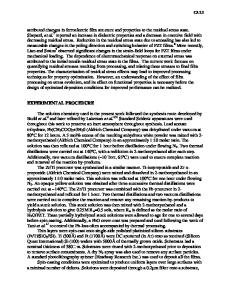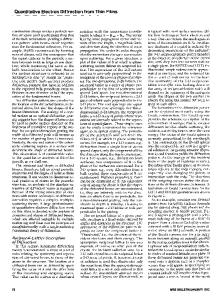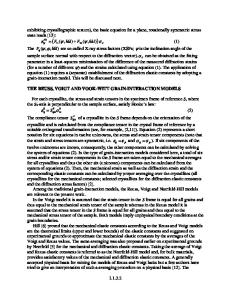Stress Determination in Textured Thin Films Using X-Ray Diffraction
- PDF / 997,389 Bytes
- 6 Pages / 576 x 777.6 pts Page_size
- 44 Downloads / 372 Views
46
diffraction to extract the stress state and the unstrained lattice parameter from thin films. We present a handbook of useful results that can be widely applied and should be mastered by anyone seriously interested in stresses in crystalline thin films with a crystallographic growth texture. The stress and unstrained lattice parameter are deduced from measured lattice spacings by modeling the material's elastic response. These models must include the orientation distribution of crystallites and the elastic constants of each crystallite. The conclusions drawn from the analysis strongly depend on the appropriateness of these models in describing anisotropy in the sample. Researchers working in the thin film field need to understand these results to work effectively on films with anisotropic properties, like crystallographic growth texture. This article will concentrate on cases where the films exhibit crystallographic texture where the film normal is a specific crystallographic direction (although some of the formalism can be extended to cases with less-well-defined crystallographic texture). These cases include epitaxial films, where the film also exhibits an in-plane orientation that mimics the orientation of the substrate, and also fiber-textured films, where the crystallites have a random inplane orientation. Both types of film are common in technological applications where growth conditions favor one particular crystallographic orientation. X-Ray Geometries Before proceeding with the discussions of stress and strain in thin films, we first present a description of diffraction geometries (Figure 1). (See, for example, Ref-
erence 8.) An essential concept is the scattering vector q, defined as: 2TT . „ = — (s - So) A
where So and s are unit vectors in the direction of the incident and scattered directions respectively, and A is the x-ray wavelength. The magnitude of q is related to 20, the angle between So and s, by Iql = 4TT sinft/A.For a given set of parallel crystalline planes with spacing d, the diffracted intensity will be a maximum when q is normal to the planes, and has length 2ir/d. This is equivalent to Bragg's law for the diffraction condition: A = 2rf sinft.In general, a diffraction experiment consists of observing the diffracted intensity as a function of a variation in the length or direction of q. Experiments which vary the length of q while holding its orientation relative to the sample constant are referred to as radial scans since the length of q is increasing in a radial direction. Radial scans examine the population of crystalline planes in a particular direction as a function of interplanar spacing. Experiments which vary the direction of q are referred to as rocking scans, or rocking curves, since they are usually performed by holding the incident and exit x-ray beams in fixed positions and rocking the sample. Rocking curves can be used to examine crystallographic texture since they examine the population of planes with a single rf-spacing as a function of orientation. In symmetric refle
Data Loading...










